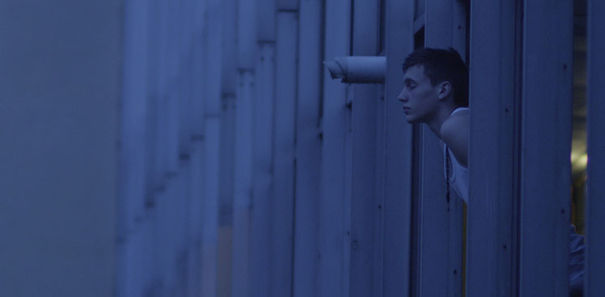Eroding Youth
Karla Lončar of the 2013 Talent Press Sarajevo reviews the visually haunting short MORNING PRAYERS, set in Sarajevo and directed by Konstantina Kotzamani and Katarina Stanković.

MORNING PRAYERS by Konstantina Kotzamani and Katarina Stanković
MORNING PRAYERS, a short film made as a part of the Sarajevo City of Film project, definitely shows that its directors (Konstantina Kotzamani and Katarina Stanković) have quite a lot to offer. They present a visually compelling coming-of-age story about youngsters who face a problem which changes their perspectives on life. Shot almost entirely during the night, its plot revolves around a teenage boy (Ismir Gagula) and a girl (Hana Pašić) who meet at a nightclub. High on drugs, they ramble through the streets of Sarajevo and talk about random things. After a while, they visit the place where she presumably lives. But instead of having sex, they encounter a dying old man in the bathtub.
What stands out is the film's attractive visual style. Boldly colorful and flashy, the scenes at the club and on the streets of Sarajevo offer a spectacular experience. Cinematographer Giorgos Karvelas did a wonderful job in creating a chilly nocturnal atmosphere, which perfectly fits the story. The directors also took their job seriously by suggesting that this atmospheric world belongs to the particular mental state of the characters. Frequent alterations of focus, interesting changes of vantage points and the use of a hand-held camera help us to get an insight into the world of drugged teenagers.
Slightly restrained and wearing lots of make-up, the girl is presented as a mysterious femme fatale, who shows up suddenly and leaves the male protagonist wondering about the sincerity of her intentions. Unlike her, he is depicted as a confused boy next door who is willing to be led, due to his narcotics-influenced passivity.
As the film proceeds to its second half, the tone slightly changes: analogous to the less hallucinatory mental state of the protagonists, illustrated with more restrained camera movements and rarer changes of perspective. This transition is accompanied by lingering ambient sounds of the morning prayers and becomes highly noticeable as the couple enters the grim-looking apartment building. However, the real split between the fantastic and more realistic ways of depicting the fictional world starts after the shocking, horror-like scene, in which the boy sees a dying old man, a man that should, as we later find out, have gone to the morning prayer.
The accent of the stylized sequences revolving around the tragedy lies in the contrast between young and old – bodies, phases of life, cultural backgrounds as well as lifestyles, which suggest two different approaches to life. This contrast orbits around the spiritual practices of young, presumably unconventional, people and older, presumably conservative, people.
It is interesting that all these differences meet in an apartment building that is so symbolic to the people of Sarajevo. Upon its construction, the so-called "Parrot building" or "Papagajka", instantly became Sarajevo's symbol of hideousness, a fact that should have been noted in the film. A couple of decades later, colourful but eroding, looking almost like a jail and filled with graffiti and smells, it fits perfectly to the directors' gloomy view on the world of young on the verge of the adulthood, facing some traumatic event which they did not expect. Precisely directed, atmospheric and visually interesting, MORNING PRAYERS represents an ambitious debut that indicates the full potential of its creators, which will hopefully lead to better films in the future.

